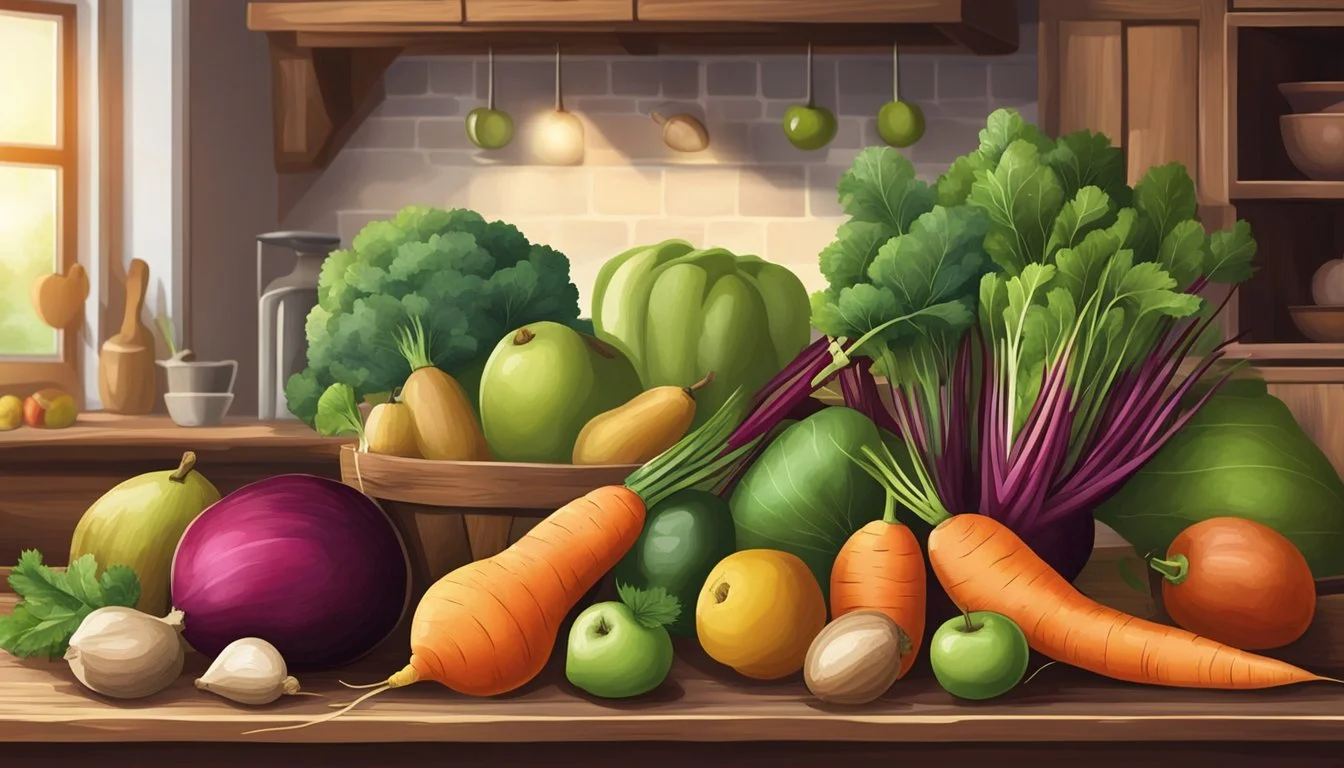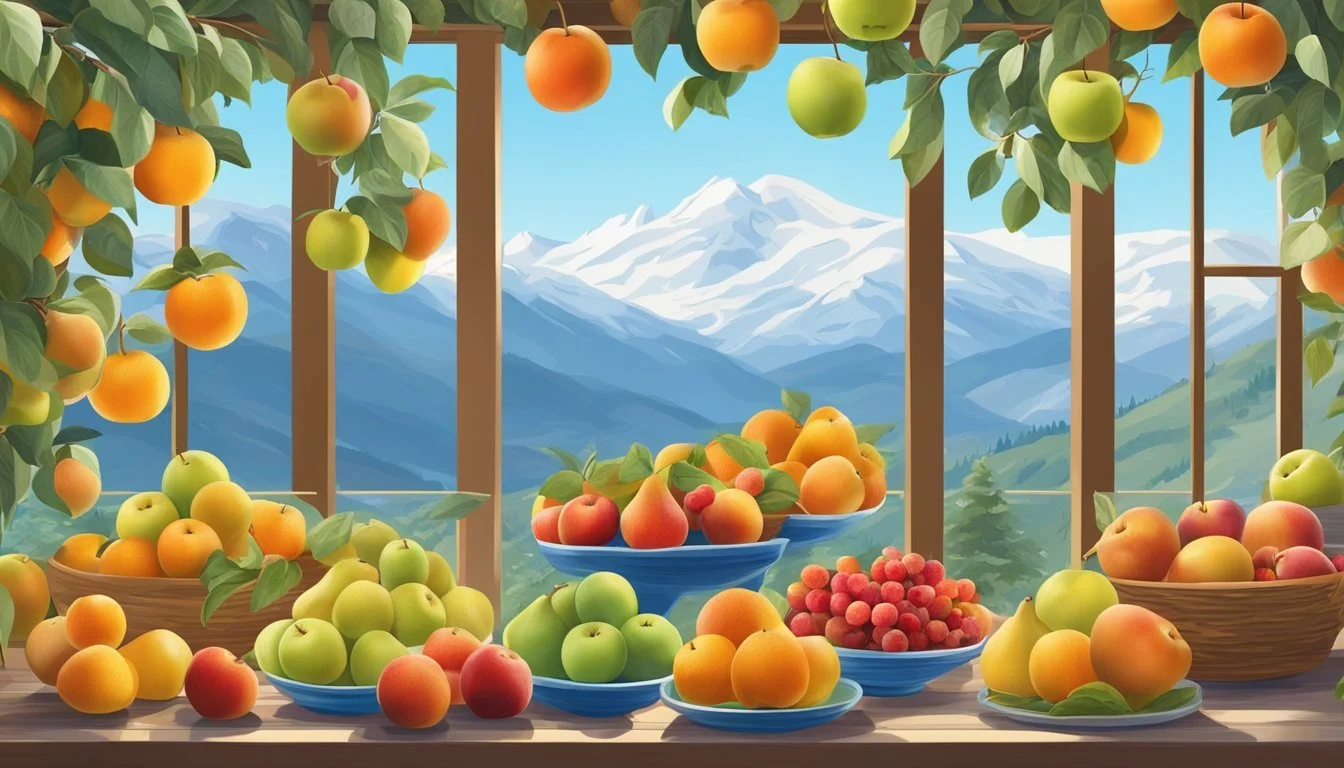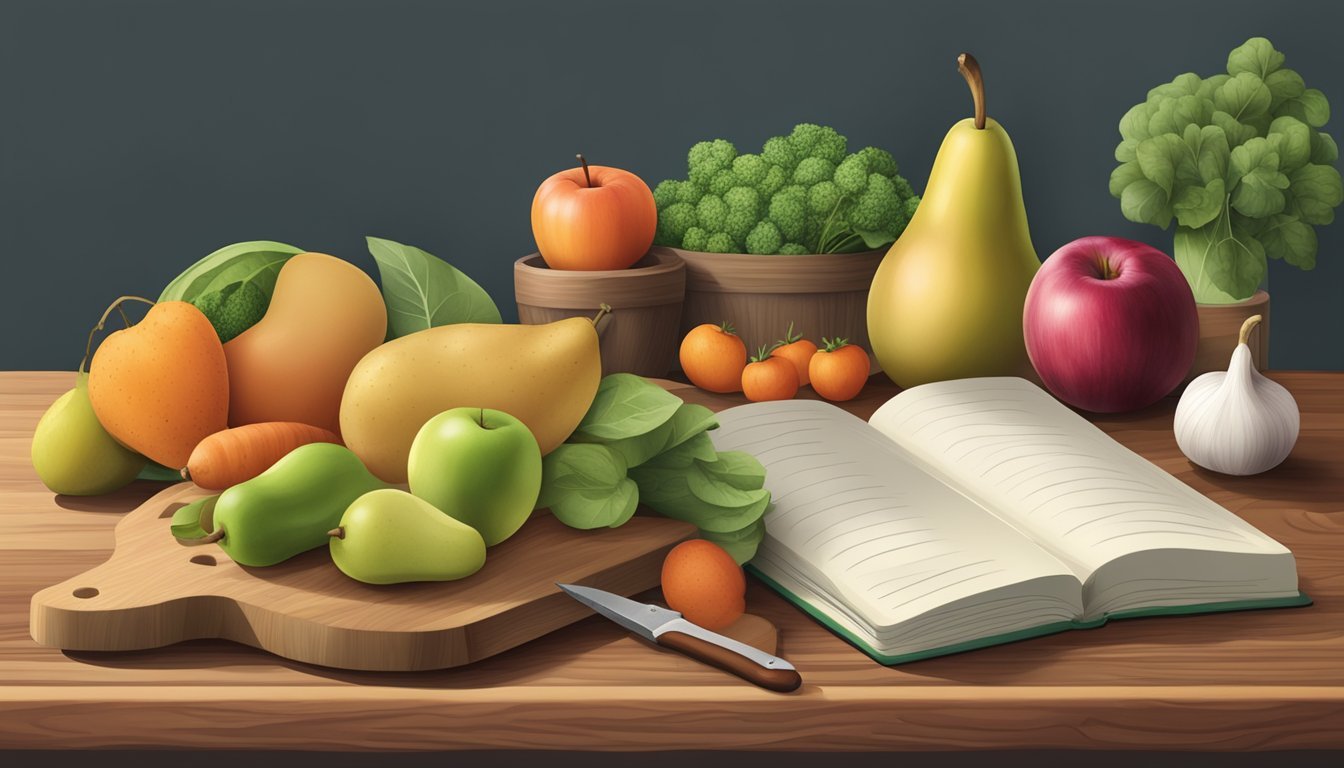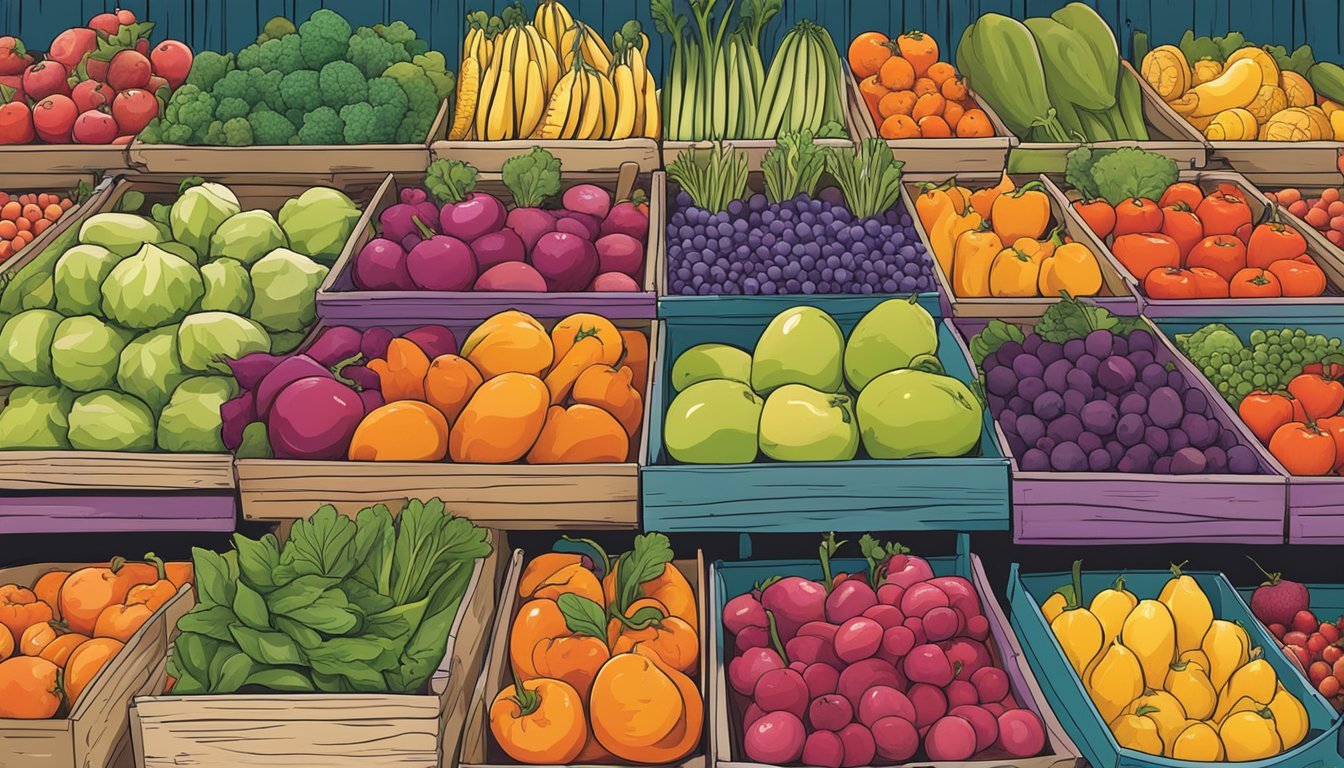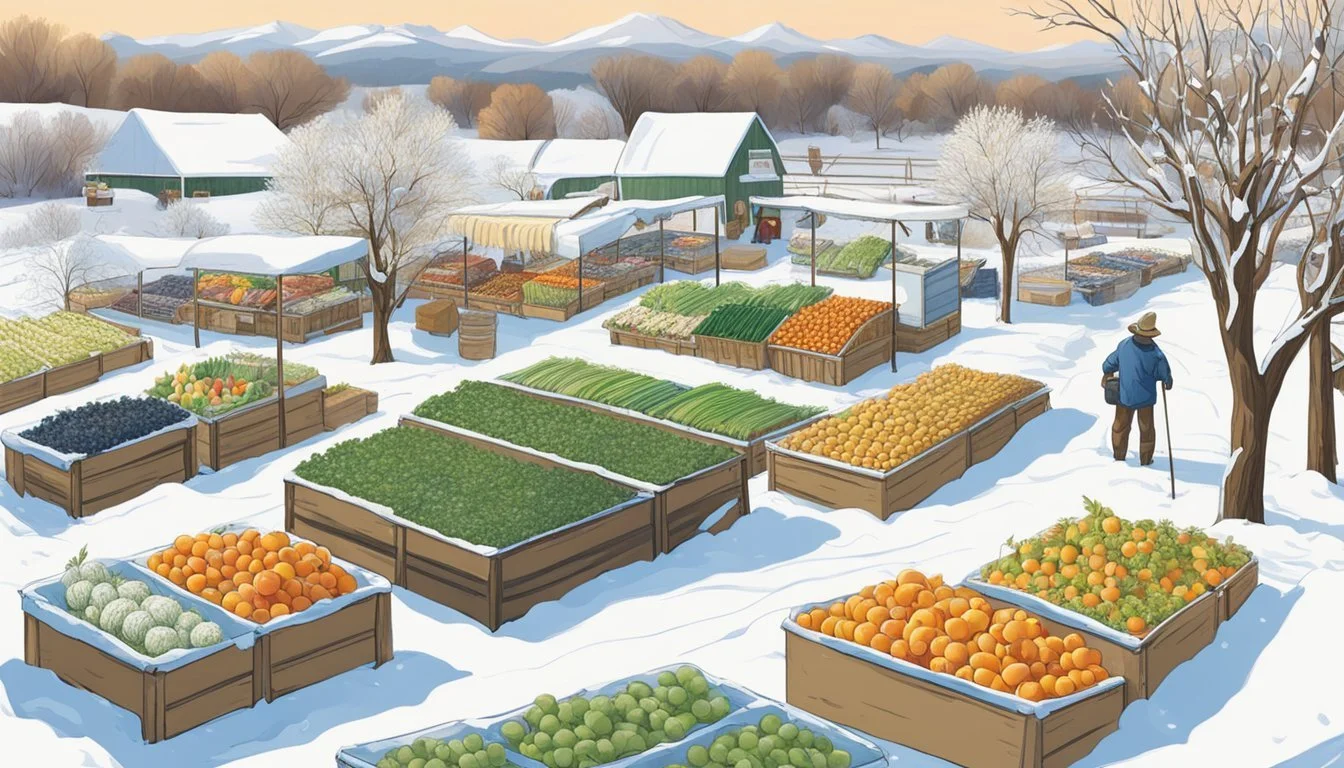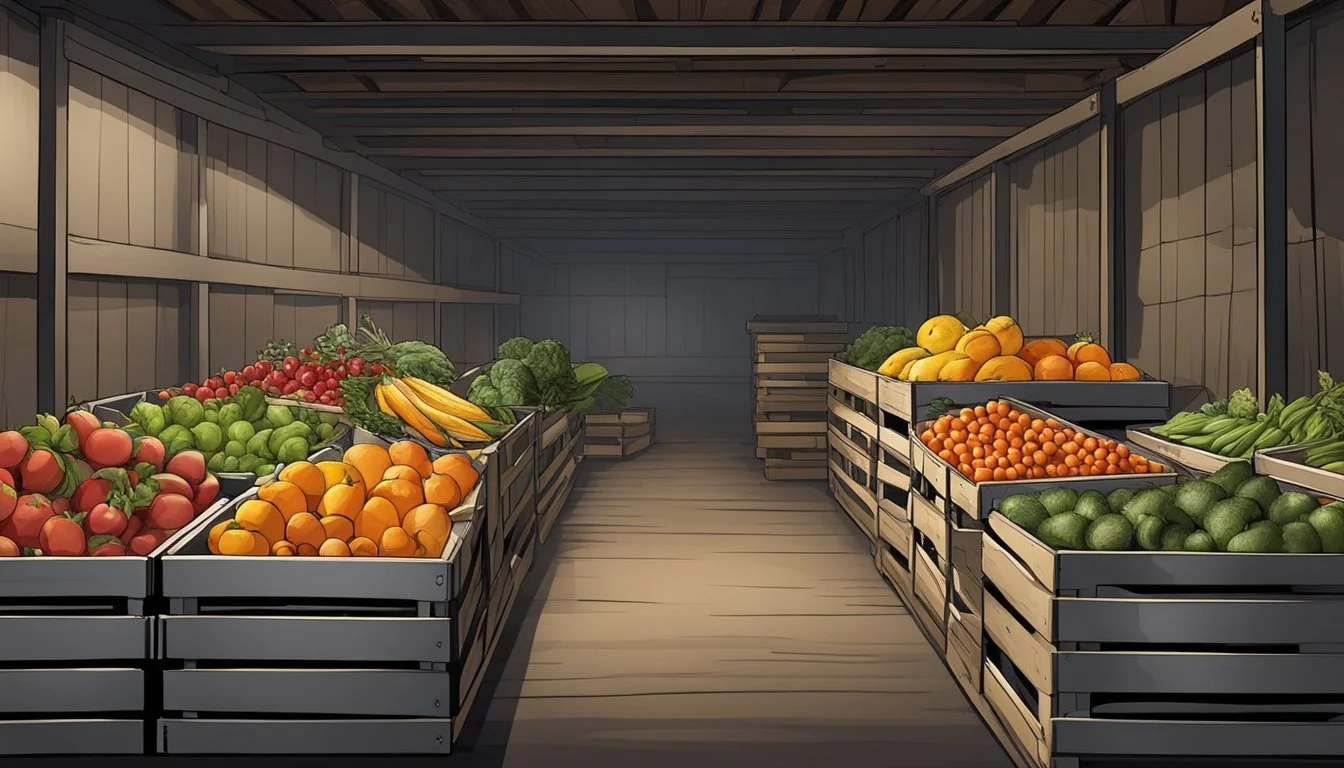Idaho Seasonal Fruit & Vegetables in February
Freshest Picks for the Month
This Article is Part of our Idaho Seasonal Fruit & Veg Calendar
In Idaho, February stands as a testament to the resilience of certain fruits and vegetables that thrive despite the cooler temperatures. Seasonal produce during this time is not only a reflection of Idaho's robust agricultural capabilities but also an opportunity for local consumers to enjoy fresh, nutrient-rich foods at peak flavor and quality. The winter months bring forth a bounty that includes the likes of root vegetables and hardy greens, highlighting Idaho's capacity to grow food year-round.
Seasonal fruits such as oranges, lemons, and apples (how long do apples last?) remain staples in the Idahoan diet during February. The state's climate allows these fruits to be stored well into the winter, ensuring a steady supply. On the vegetable front, Idaho offers a variety of root vegetables like sweet potatoes (What wine goes well with potatoes?) and carrots (how long do carrots last?), as well as winter squashes, onions, and leeks. These vegetables not only withstand the cold but also provide comforting flavors and nourishment in winter meals.
Produce availability in February aligns with the need for hearty and warming dishes. Cruciferous vegetables such as Brussels sprouts (how long do brussels sprouts last?), broccoli, and kale are also prominent, offering versatility for various cooking methods, from roasting to steaming, each method coaxing out rich flavors and textures. This period of seasonal eating encourages a sustainable approach to consumption while supporting Idaho's local farmers and producers.
What Is in Season in Idaho During February
During February, residents and visitors of Idaho can experience some of the freshest produce the winter season has to offer. February is a time when the state's agriculture shines with a variety of fruits and vegetables that are ripe and ready for consumption. Buying in-season produce not only supports local farmers but also provides ingredients at their peak flavor and nutritional value.
Fruits that one can expect to find in abundance include:
Citrus fruits: such as grapefruits, which are juicy and packed with Vitamin C.
For vegetables, the selection is broader, providing an array of hearty options for winter meals:
Root vegetables: including beets and celery root, known for their earthy flavors and versatility in cooking.
Leafy greens and cabbages: such as chicory, which can be enjoyed in salads or cooked for a warm dish.
In February, considering the cold and often fluctuating weather conditions of an Idaho winter, root vegetables and certain greens thrive due to their resilience against the frost. Seasonal eating ensures one receives plenty of nutrients while indulging in produce that tastes best when harvested at this time of year.
To summarize, Idaho's February offerings cater to a mix of fresh, in-season produce that complements the winter climate. These seasonal fruits and vegetables bring warmth and nutrition to the dinner table during the colder days.
Highlighting Seasonal Fruits
In Idaho, February is marked by the peak season for several fruits, particularly citrus which is renowned for its vibrant flavor. These fruits are not only enjoyable on their own but also offer a burst of freshness to various dishes during the winter months.
Citrus Fruits
Citrus fruits are abundant during February, offering freshness and a punch of Vitamin C. Shoppers can find a variety of citrus, including:
Oranges: Standard navel oranges are readily available and perfect for juicing or eating fresh.
Blood Oranges: Notable for their deep red flesh and slightly berry-like flavor.
Lemons: Including the common Eureka lemons and the sweeter, less acidic Meyer lemons.
Grapefruits: Ruby grapefruits with their juicy, tart, and slightly sweet flavors.
These fruits serve as nutritious options, great for immune support during the colder season.
Pears
Pears, another winter fruit, continue to be available in February. With a sweet, buttery texture, pears are versatile and can be used in cooking or eaten raw. They complement both sweet and savory dishes, adding a subtle, refined sweetness.
Spotlight on Seasonal Vegetables
In February, Idaho offers a bounty of seasonal vegetables that are both flavorful and nutritious. Root vegetables, green leafy vegetables, and cruciferous vegetables are particularly abundant during this month, providing a variety of options for winter meals.
Root Vegetables
Root vegetables thrive in Idaho's winter months, with their ability to store well and stay fresh in colder temperatures. Key root vegetables to look for include:
Carrots: Sweet and crunchy, high in beta-carotene, perfect for roasting or stews.
Potatoes: A versatile staple, available in numerous varieties; ideal for mashing, baking, and soups.
Sweet Potatoes: Rich in fiber and vitamins, sweet potatoes can be baked, mashed, or used in casseroles.
Leeks: With a mild onion flavor, leeks enhance soups and pairs well with potatoes.
Each of these root vegetables can be the foundation of a hearty winter dish or a complementary side.
Green Leafy Vegetables
Although the winter months can be challenging for some green vegetables, certain varieties still thrive:
Kale: This hardy green is rich in nutrients and can withstand cold temperatures, making it a go-to for salads or a sautéed side dish.
Collard Greens (how long do collard greens last?): Similar to kale, collard greens are resilient in cooler weather and can be cooked down to a tender texture, often flavored with garlic or ham.
These greens are not only healthy but also add a pop of color to any winter plate.
Cruciferous Vegetables
February in Idaho sees several cruciferous vegetables at their best. These include:
Broccoli: Known for its high vitamin C content, it can be enjoyed steamed, roasted, or in stir-fries.
Cauliflower: Its mild flavor allows it to be very versatile in recipes, including soups and as a substitute for rice.
Brussels Sprouts: When roasted, these become a sweet and tender treat, full of antioxidants.
Cabbage: It can be used in a variety of dishes from slaws to soups, adding texture and flavor.
These vegetables are not only packed with vitamins and minerals but also provide fiber and can be a key component of a balanced diet.
Recipes and Cooking Tips for February Produce
February in Idaho brings an abundance of root vegetables and hearty greens to the table. Utilizing these ingredients not only supports local economy, but also ensures freshness and nutrition in every dish. Here are some ideas to inspire your cooking with February's seasonal produce.
Soups and Stews
Root vegetables like turnips and carrots are superb for adding depth and sweetness to soups and stews. They can slow-cook to perfection, releasing flavors that complement both meat-based broths and vegetarian options. A classic beef stew (What wine goes well with beef stew?) can be elevated with chunks of Idaho potatoes, diced carrots, and slices of parsnip. For vegetarian fare, a creamy potato leek soup demonstrates the silky texture potatoes can offer when blended with rich vegetable stock and aromatic herbs.
Side Dishes
Side dishes in February can be both nutritious and warming. Roasted root vegetables can become a staple; beets, carrots, and sweet potatoes tossed in olive oil, seasoned with thyme and rosemary, and then roasted until caramelized, offer a burst of natural sugars and complex flavors. Sauteéd leafy greens, like kale and Swiss chard, can be quickly prepared with garlic and a splash of lemon juice, making for a refreshing and vitamin-packed accompaniment.
Salads
Salads in the cooler months can incorporate more than just leafy greens. Grains like farro (how long does farro last?) or quinoa (how long does quinoa last?) can be the base, providing substance and texture. Add roasted cubes of butternut squash (how long does butternut squash last?), thinly sliced apples, and a generous sprinkling of goat cheese for a salad that’s both hearty and flavorful. Dress the salad with a vinaigrette made from lemon juice and olive oil to cut through the richness and brighten the dish.
Desserts
Desserts featuring Idaho's February produce can range from rustic to refined. Apples, held over in cold storage after the fall harvest, still retain their flavor and can be baked into an apple crisp with a dash of cinnamon and nutmeg(how long does nutmeg last?). Citrus fruits like oranges and grapefuits can be turned into a citrus curd for a zesty tart filling, providing a sun-kissed flavor to any winter's day.
Health Benefits of February Produce
Eating seasonal produce in February provides numerous health benefits. Foods such as apples and beets, which are commonly available in Idaho during this month, are rich in essential nutrients that support overall wellness.
Apples are an excellent source of fiber, which is crucial for digestive health. They also contain vitamin C, fruitful in boosting the immune system and protecting the body against infection. The antioxidants found in apples, such as quercetin, help combat inflammation and may lower the risk of chronic diseases.
Beets are another staple in February's seasonal basket. They provide a hearty dose of fiber, folate, and manganese. The presence of nitrates in beets is particularly beneficial, as they help to improve blood flow and lower blood pressure. Beets also house a good amount of vitamin C, contributing to skin health and immune function.
Nutrient Profile of Selected February Produce
Produce Key Nutrients Apples Fiber, Vitamin C Beets Fiber, Vitamin C, Folate, Manganese
Consuming seasonal produce like apples and beets not only offers a more flavorful experience but can also be more cost-effective. Additionally, using these fruits and vegetables at their peak can support local farmers and reduce the carbon footprint associated with long-distance food transport.
One must not overlook the impact of variety in a diet. Including different fruits and vegetables throughout the seasons can lead to a more diverse intake of vitamins and minerals, which is integral to maintaining a healthy body.
Understanding Idaho's Seasonal Produce Patterns
In Idaho, the rhythm of seasonal produce is dictated by the state's varying climate. During February, the selection is more limited due to the cold weather conditions. This period is characterized by the tail end of winter's bounty and the beginning of some early spring harvests. Residents and chefs alike adjust their menus to incorporate the offerings of the season.
Winter squash, a durable and versatile vegetable, remains a staple. Known for its ability to be stored for months, winter squash varieties such as butternut, acorn, and spaghetti are commonly available and utilized in hearty, warming dishes in February.
Idaho's cold climate means that much of the traditionally grown produce is out of season. However, several cold-tolerant greens and root vegetables are still available:
Root vegetables: Potatoes, beets, and carrots
Greens: Kale and certain types of lettuce that can withstand the chill
Apples: Stored from fall harvest, they remain crisp and nutritious
Here is a simplified list of seasonal produce one might find in Idaho during February:
Vegetables Fruits Winter Squash Apples Beets Carrots Potatoes Kale Brussels Sprouts
The state's agricultural practices adapt to the cold, with many farmers implementing greenhouses or indoor farming techniques to extend the life of certain crops. This means that while the assortment is less diverse, the quality and freshness of winter produce is maintained at a high standard.
Supporting Idaho's Local Farmers and Economy
Idaho's robust agricultural sector is a cornerstone of its economy, and supporting local farmers is crucial for sustainable development. The state is known for its wide variety of locally grown products, with a significant portion of its farms being family-owned, pointing to a tradition of agricultural heritage and community values.
Local Impact When consumers purchase locally grown produce, they are directly contributing to the local economy. Research suggests that $68 of every $100 spent on local businesses remains in the local community, compared to $43 when spent on non-local businesses.
Idaho Preferred The initiative known as "Idaho Preferred" is at the forefront of promoting local produce. Consumers are encouraged to look for this label, which indicates that a product is grown, raised, or crafted in Idaho. This program not only supports the local farmers but also ensures consumers have access to fresh and high-quality products.
Choosing Local February in Idaho does limit the range of fresh produce due to seasonal constraints. However, consumers can continue to support local farmers by:
Seeking out stored root vegetables still available
Purchasing local greenhouse-grown produce
Selecting Idaho-made value-added products such as jams, bread, and cheeses
Engagement with Farmers Community engagement with local farmers can take various forms, such as:
Visiting local farms where possible
Shopping at farmers' markets
Participating in community-supported agriculture (CSA) programs
By making these conscious choices, individuals not only enjoy fresh, quality food but also help maintain the economic vigor and the long-standing tradition of Idaho's farming communities.
Preservation and Storage of Seasonal Produce
In Idaho, the cold month of February still offers a variety of seasonal fruits and vegetables. Ensuring the optimal preservation and storage of these products allows consumers to enjoy their peak flavors.
Drying is a reliable method for preserving fruits and vegetables. Thinly slicing and dehydrating these foods using a dehydrator or an oven increases their shelf life while concentrating their flavors.
For vegetables that thrive in February like root vegetables, the best storage practice is to keep them in a cool and dark place, ideally in a root cellar or a similar environment that mimics such conditions. Here, they can last for several months when stored properly.
Fruit storage, on the other hand, may require refrigeration to maintain freshness. Many fruits have a higher moisture content and are therefore more perishable. They should be stored in the refrigerator's crisper drawer where the temperature and humidity levels help maintain their quality.
Below is a summarized table listing common preservation methods aligned with the nature of February's seasonal produce in Idaho:
Produce Type Preservation Method Storage Location Fruits Refrigeration Crisper drawer of fridge Root Vegetables Cool, dark place Root cellar Leafy Greens Blanched and frozen Freezer
Consumers are encouraged to consume their produce at its peak when nutrient levels and flavors are most pronounced. Following these storage guidelines assists in extending the life of February’s seasonal bounty while retaining its nutritional value.
Impact of Climate on Idaho's Seasonal Fruits and Vegetables
Idaho's climate plays a crucial role in the growth and availability of seasonal fruits and vegetables. The state experiences a range of climatic conditions with cold winters and warm summers, influencing what can be grown and when. The climate, defined by its distinct seasons, dictates the sowing and harvesting schedules for various crops.
During February, the cold temperatures and frost in parts of Idaho may limit the range of available fresh produce. Farmers often rely on cold storage from previous months' harvests or on crops that can withstand cooler temperatures.
Typical February Produce:
Root Vegetables: Such as carrots and potatoes, which are often stored from previous harvests and remain available.
Winter Squash: Stores well and is often used throughout the winter months.
Hardy Greens: Some greens, like kale, can thrive in cooler climates or are grown in greenhouses.
The state's farmers must adapt to the weather patterns, ensuring that water from snowmelt is effectively utilized. This water is crucial for spring and early summer crops, as Idaho's dry, warm summers can otherwise stress plants.
Key Climate Factors:
Temperature: Influences the types of crops that can survive winter.
Snowmelt: Provides essential water for spring and early summer irrigation.
Precipitation: Affects soil moisture levels, influencing planting and harvest times.
In conclusion, Idaho's climate has a significant impact on the cultivation and seasonal availability of fruits and vegetables. The state's producers continue to adapt to these climatic challenges to ensure a diverse and sustainable food supply.

